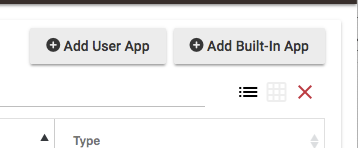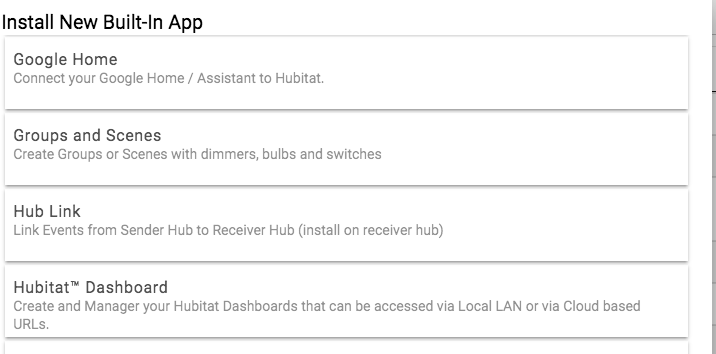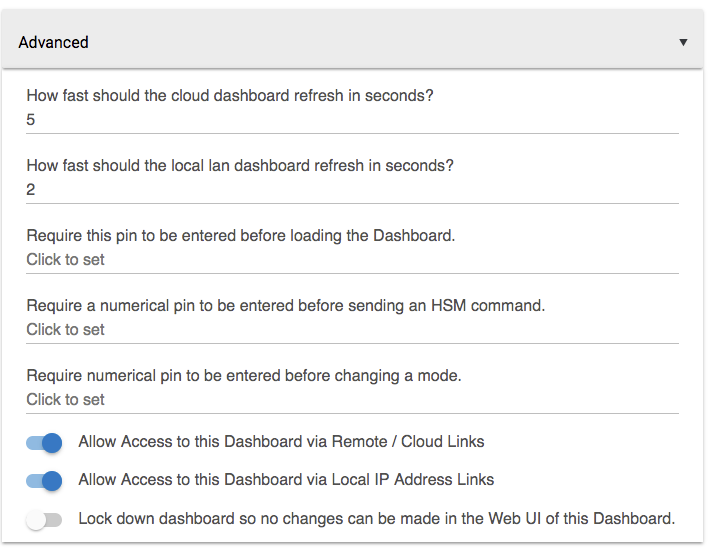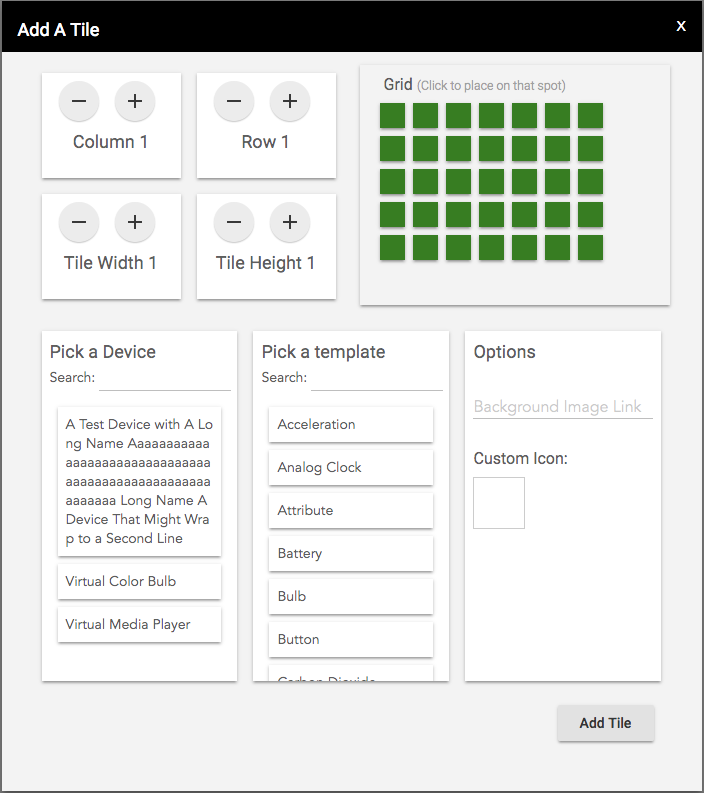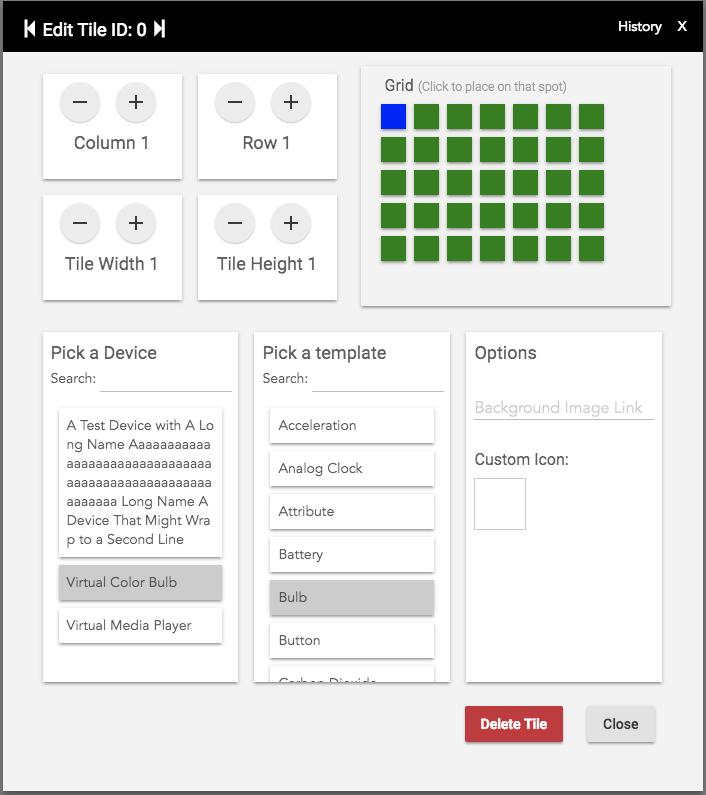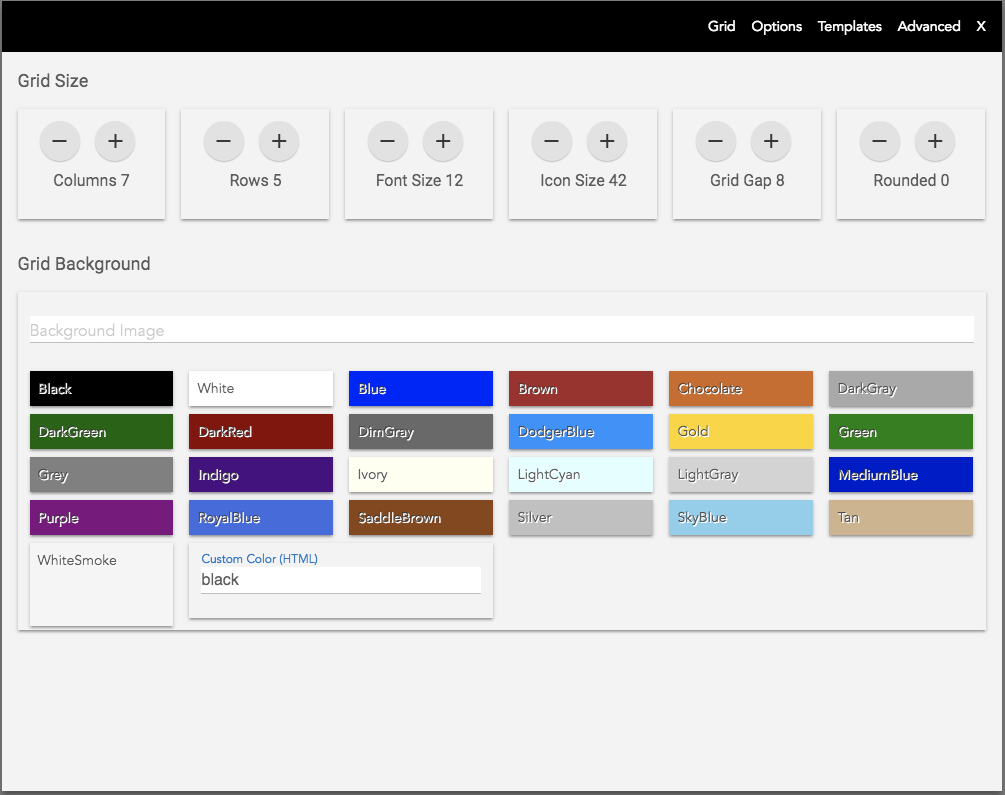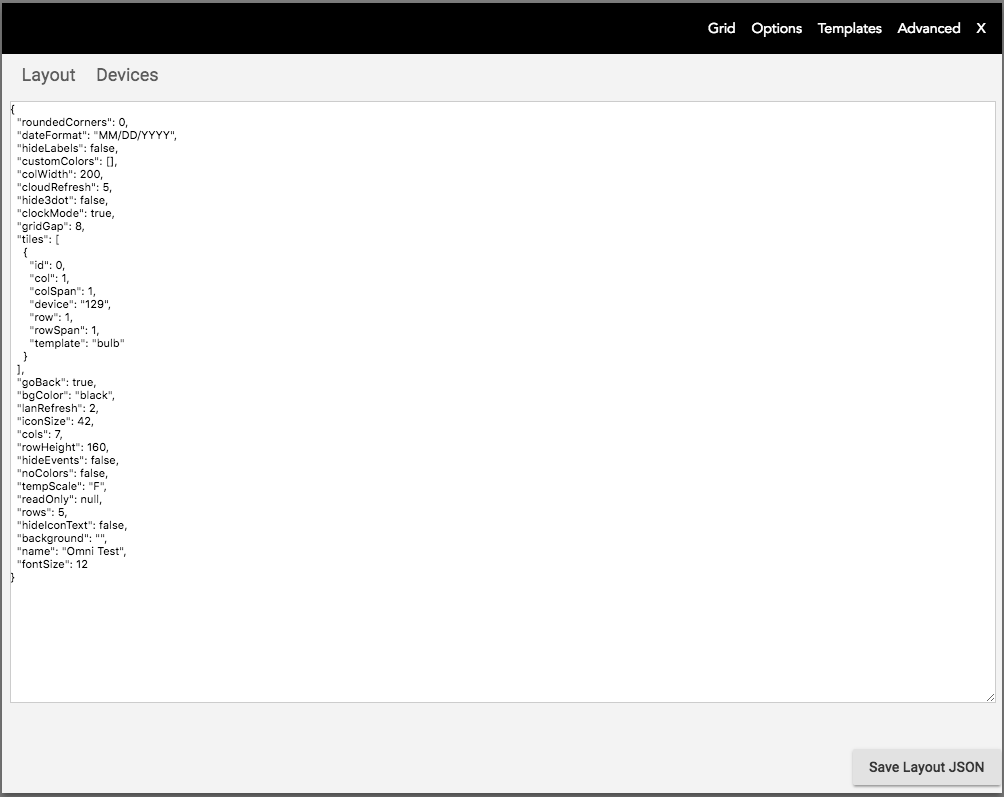Hubitat® Dashboard
Hubitat® Dashboard gives you remote access to monitor and control your devices from your phone, tablet or desktop. This is a highly customizable dashboard that lets your choose the devices and layout you want to see. You can even set up multiple dashboards if you want to provide custom dashboards for each member of your house. Here's how to set it up.
Contents
Creating Your Dashboard
- Load the Hubitat® Dashboard App in the Hubitat Web Interface.
- Scroll to "Hubitat® Dashboard" and click it to install.Dashboard App Menu
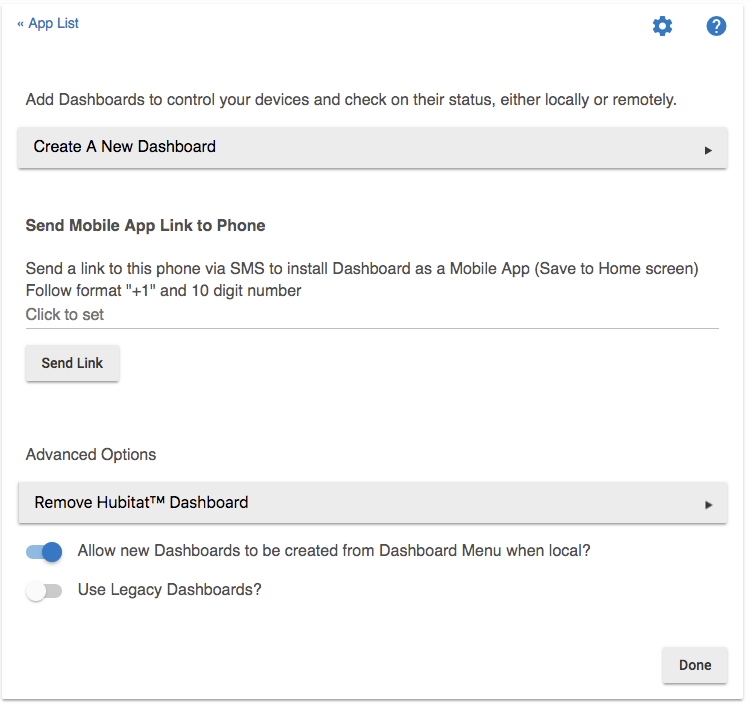 Send Mobile App Link to Phone option allows you to text a link to someone to access the Hubitat Dashboard Menu remotely. Dashboard Menu Once you have your first dashboard created, you will have a list of dashboards for quick access here. You can switch between Local and Cloud links using the two tab buttons Advanced Options Remove Hubitat Dashboard allows you to remove this app. Allow new Dashboards to be created from Dashboard Menu. This option allows you to control if you want to allow new dashboards to be created or not from the dashboard menu. Use Legacy Dashboards? This allows you to go back to Dashboard 1.0 rendering. Keep in mind if you add any new template tiles this could cause the legacy dashboard not to render.
Send Mobile App Link to Phone option allows you to text a link to someone to access the Hubitat Dashboard Menu remotely. Dashboard Menu Once you have your first dashboard created, you will have a list of dashboards for quick access here. You can switch between Local and Cloud links using the two tab buttons Advanced Options Remove Hubitat Dashboard allows you to remove this app. Allow new Dashboards to be created from Dashboard Menu. This option allows you to control if you want to allow new dashboards to be created or not from the dashboard menu. Use Legacy Dashboards? This allows you to go back to Dashboard 1.0 rendering. Keep in mind if you add any new template tiles this could cause the legacy dashboard not to render. - Click on Create a New Dashboard
- Give your dashboard a name. This name will appear at the top of the dashboard. Pick something descriptive such as the room this dashboard is controlling or its main purpose.
 In Links you have your local and cloud links to your new dashboard. These are standard Web URLs that you can bookmark to directly access your dashboards. Local LAN link is accessible inside your house while on the same network and features instant updates. Cloud Links are remotely accessible URLs that you can use to access your dashboard from outside your network. Under Advanced you can set some options you can’t change in the actual dashboard.You can change how fast the dashboard should refresh via cloud and local links. You can set a Pin / Password to protect this dashboard from loading. You can also set numerical (only numbers) PIN for HSM and Modes. You can also turn off access for this dashboard from the Cloud and/or Local links. Lastly, you can set this dashboard to “Read Only” which will not allow any changes from inside the dashboard app itself.
In Links you have your local and cloud links to your new dashboard. These are standard Web URLs that you can bookmark to directly access your dashboards. Local LAN link is accessible inside your house while on the same network and features instant updates. Cloud Links are remotely accessible URLs that you can use to access your dashboard from outside your network. Under Advanced you can set some options you can’t change in the actual dashboard.You can change how fast the dashboard should refresh via cloud and local links. You can set a Pin / Password to protect this dashboard from loading. You can also set numerical (only numbers) PIN for HSM and Modes. You can also turn off access for this dashboard from the Cloud and/or Local links. Lastly, you can set this dashboard to “Read Only” which will not allow any changes from inside the dashboard app itself.
- Next, decide if you want to authorize all devices to the dashboard or just a select few devices. You can choose specific devices by toggling the Use all your devices switch to Off. If you want to pick only a few devices, select Choose Devices and check the devices you want to see on your dashboard. Limiting the devices in larger installs will speed up the loading of dashboard.
- Click “Done” and your first dashboard is installed.
Overall, Hubitat® Dashboard is a very powerful, fast grid-based tile solution. We hope you enjoy using your dashboards. More tile templates are in the works and please provide your feedback in the community thread for dashboard tiles and we can see what we can do to accommodate your needs.
Accessing Dashboards
Accessing Your Dashboard(s)
Now that we have your first dashboard set up, let’s head over to it. Click the local link and open your new dashboard in a new window.
You will now see the Getting Started dialog box.
This will tell you a bit about how Dashboard 2.0 works. You have a couple options to get started. You can Manually Add Tiles (or just close this dialog) and get started or you can select Auto Fill Grid and all your devices will be automatically added to the dashboard with a default tile template.
You can also use the new “Dashboard Builder” by clicking on it in the menu bar.
Dashboard Builder allows you to create a dashboard based on the devices you have authorized and their specific “attributes”. Select which ones you want to create and you can then click “Build My Dashboard” to create a quick and easy dashboard that contains groups of each of these types of devices.
Both Auto Fill Grid and Dashboard Builder automatically optimize their default Grid Size for the browser you are currently using. It is best to use the browser you intend on using so this process builds a dashboard specifically for your device.
Add A Tile
Clicking on the “+” icon in the top right opens the Add A Tile dialog.
This allows you to set the column and row by either using the -/+ buttons or clicking anywhere on the grid.
You can also change the tile width and/or tile height to set how big the tile will be.
Then pick a device, a template and set the options for that template. Finally click Add Tile and you will see the tile added to your Dashboard in the spot you selected.
You will notice the Grid should change to gray in that spot where the grid now has a tile.
Edit Tile
You can edit any tile by clicking the 3 dot menu in the top right of any tile.
This will open up and allow you to move the tile around on the grid by clicking the -/+ or the grid layout and you will notice the tile will move to that spot.
You can quickly jump between tiles by using the back and forward buttons next to “Edit Tile: X”
“History” will open up a list of activities for that device from the event table.
You can change the Device and/or template or change any Options for the tile.
If you want to remove the tile, click the “Delete Tile” button.
Settings
Clicking the gear icon in the top right opens up the Settings page for this dashboard.
There are 4 distinct options: Grid, Options, Templates and Advanced
Grid
You can change the grid size (columns and rows), font size, icon size, grid gap and how rounded the corners are for all tiles
You can also paste in a URL for a background image or set a color including a custom HTML value for the background of the grid.
Options
Here you can change a variety of options on how your dashboard will display (or not) information.
Clock 12 Hour mode, turn off for 24 hour time display in any clock template or history
Date Format, switch between MM/DD and DD/MM formats
Cloud and LAN refresh intervals, set these to determine how fast it polls. NOTE: LAN refresh is only if dashboard can’t connect via websocket. When connected via websocket, updates should be immediate.
Column Width and Row Height. Remove these to auto fit tiles to grid, or change these to specific values to force the dashboard to render these tiles as fixed sizes and this will allow the dashboard to scroll if it overflows the browser window.
Allow Logo Click. Disable this if you don’t want the option to return to the dashboard menu.
Hide 3 dots. This will hide all 3 dot options in tiles. You will need to re-enable these if you want to edit tiles (NOTE: This is not read only, that can be set inside the Dashboard App settings in the Hubitat Web Interface)
Hide Tile Template Names. This allows you to remove the names that are at the top of most templates.
Hide Icon Helper Text. This will hide the text under each icon that indicates the attribute value.
Hide Device History. This will remove the option to view device history in the tile details area.
Do Not Use Default Tile Colors. Turning this on will disable the default colors for templates.
Templates
In this area you can change the Color, Background Color and Custom Icons for each state available for a template.
Advanced - Layout
This area allows you to copy and paste in layouts or make direct edits to your options, layout and custom colors. Quickly share custom colors or layouts using this area.
Advanced - Devices
This area allows you to see a list of authorized devices, the current states and history (if enabled) for each device. This is helpful to troubleshoot if a device is reporting proper states.
